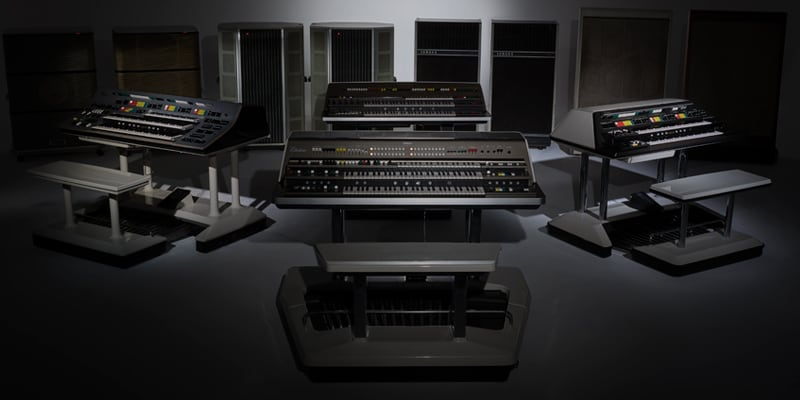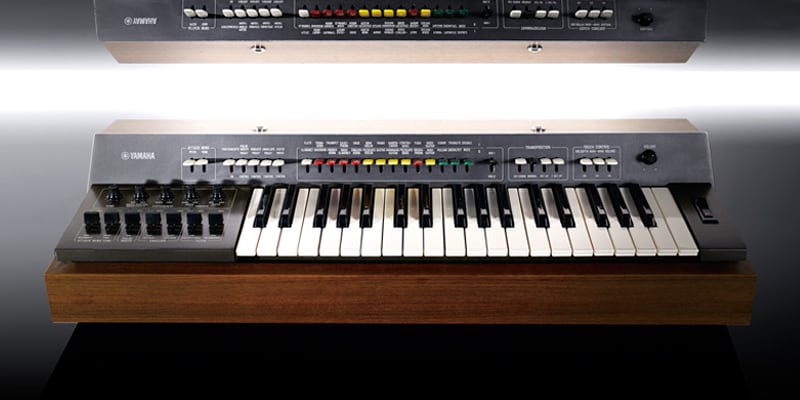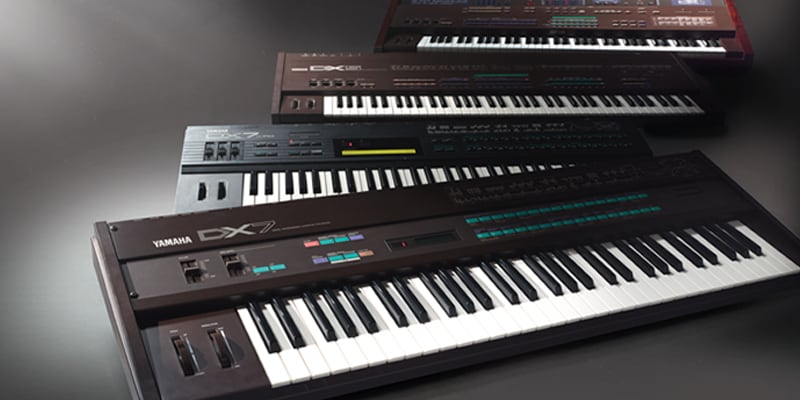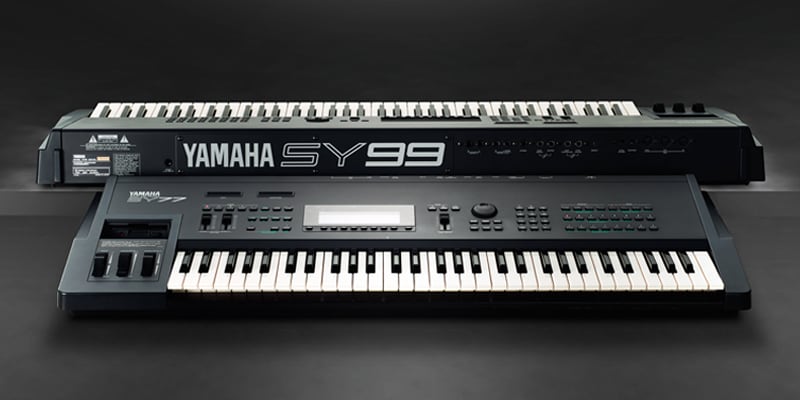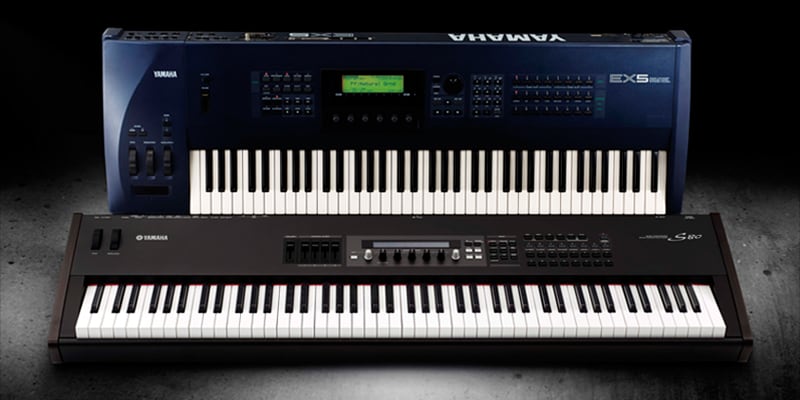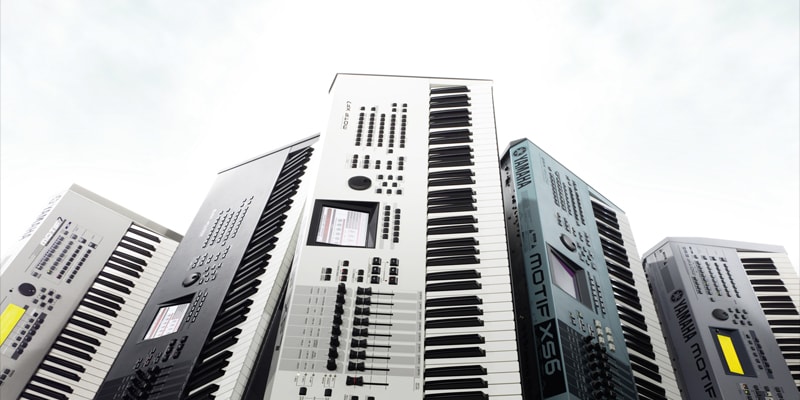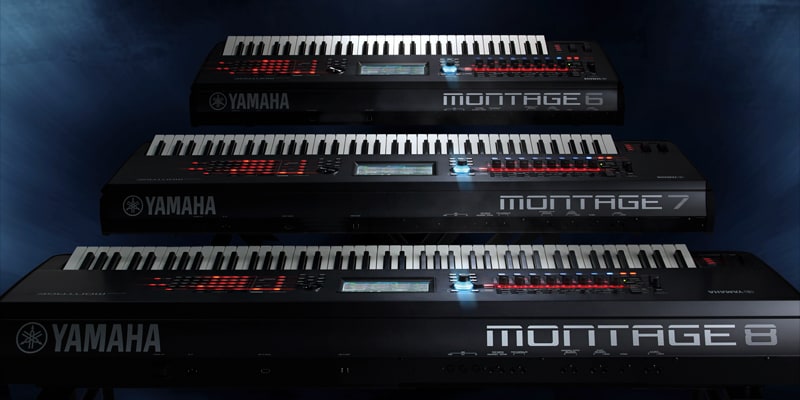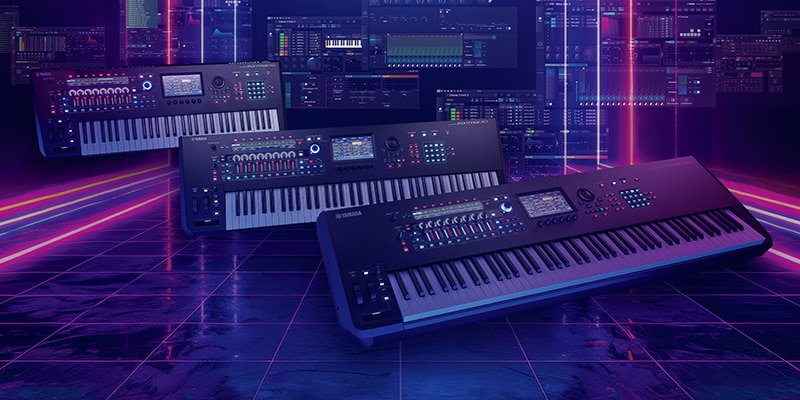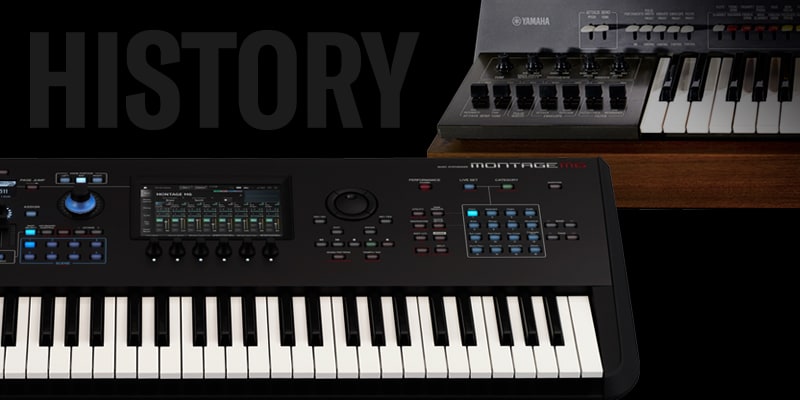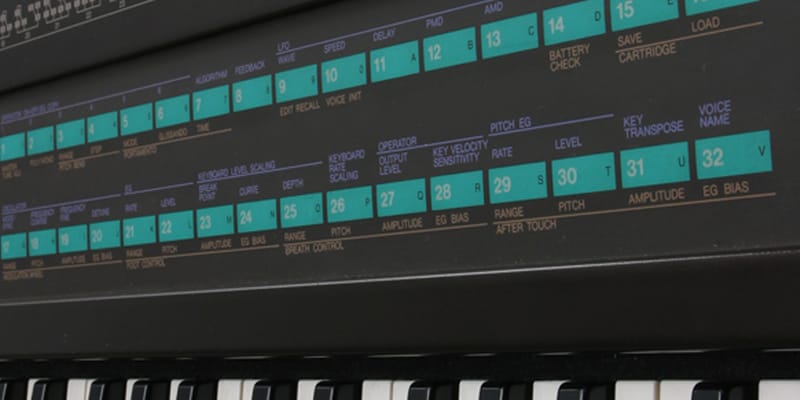Chapter 7: Instruments that Create Sound
Using Technology to Pinpoint What Creates Sound

In February 2020, Yamaha released the YC61, a stage keyboard featuring the newly developed Virtual Circuitry Modeling (VCM) Organ tone generator. The following year, we released the YC73 and YC88 to round out the series at three models. Although these are stage keyboards rather than synthesizers, they are internally indistinct from the latter since they contain AWM2 and FM tone generators in addition to the VCM Organ tone generator. We chose “YC” for the model name in a nod to the YC-10 combo organ released in 1969, a series that would go on to fuel the “band boom” of the 1970s.
Although intended to be based on a different concept to Yamaha Electone electronic organs, the series shared the same audio output system as the Electone. Fifty years later, we have revamped the YC Series with the new VCM tone generator. Interestingly, the underlying VCM technology originated as a research project of K’s Lab, an in-house research team headed by Toshifumi Kunimoto, a doctor of Information Science also known as “Dr. K.”
The team was formed in 1987 to develop the next generation of tone generator systems after the commercialization of our FM and AWM tone generators. The lab was engaged in a groundbreaking effort to mathematically determine the principles by which acoustic instruments produce sound, laying the groundwork for the Virtual Acoustic (VA) tone generator that would appear on the VL1 synthesizer in 1993. However, calculating the acoustic characteristics of conical wind instruments such as saxophones required such a vast number of formulae that the VA tone generator would overwhelm the digital signal processor (DSP) technology available at the time.
In search of a solution, K’s Lab discovered a paper on branching theory published in Japanese in 1977 (Note 1). Branching theory holds that the acoustic characteristics of a conical pipe can be approximated by two cylindrical pipes. Using this theory, the lab used cylindrical pipes of a fixed diameter to simplify the formulae, making the new tone generator system more practical, which lead to the release of the VA tone generator. Incidentally, we applied branching theory beyond the field of electronic simulations, using it to design the Venova, a casual wind instrument. The fully acoustic instrument debuted in 2017 and won the Good Design Award in Japan.

Note 1:
Ensui horn no hankyoshin shuhasu no kyumenha riron ni yoru kaiseki - ensui-gata kangakki no naru shuhasu (Analysis by the spherical wave theory of the anti-resonant frequency of a conical horn - Sounding frequency of cone wind instrument), Junichi SANEYOSHI, 1977.
K’s Lab was involved in the development of many more tone generators after the VA, including the AN1x (1997) – a DSP-based analog modeling synthesizer – and the EX5 (1998), which featured the Extended Synthesis hybrid tone generator system. Around 2001, the lab began developing effects using physical models of analog circuits. Analog circuits, made up of capacitors, transistors, and other components, vary slightly even when using parts with the same specifications. These small differences, especially in sound and other electrical signals with varying frequencies, have a substantial effect on the audio output. In other words, two effectors with the same function can sound different if their analog circuits contain different components or were assembled differently. This is why musicians and engineers carefully select products, as these subtle variations influence the overall sound quality and performance.

K’s Lab studied analog circuit behavior and developed digital effects using physical models for several mixing consoles, including the Yamaha DM2000VCM professional digital mixing console (2000), the first product with “VCM” in the name. As it continued to evolve, VCM technology was integrated into many more products, including Open Deck, which simulates tape recorder characteristics, and RND Portico plugins, a collaborative effort with Rupert Neve Designs.
Along the way, the developers of the YC61 applied this VCM technology to simulate analog circuits and other physical phenomena using DSP, focusing on recreating the authentic sound of a tonewheel-type organ tone generator.

Unlike electronic oscillator-based organs, tonewheel-type organs generate sound through electromagnetic induction created by rotating metal gears near the pickup – similar to how an electric guitar’s strings vibrate above pickups. In a tonewheel organ, the rotation of gears with jagged teeth changes the distance between the metal and the pickup, creating varying frequencies. The number of teeth and the rotation speed determine the pitch.
Actual organs use a combination of tonewheels to create both the fundamental pitches and harmonics for each note, controlled with levers called drawbars. Mechanical factors, such as gear shape and rotation speed, variance in the physical shape of the gears, and other factors impact the sound. The pickups, which consist of magnets and coils, add even more factors, including the type of magnet used, the number of times the coils are wrapped, and the thickness of the wire.
The VCM Organ tone generator utilized VCM technology to allow DSP to compute all these parameters for a realistic organ sound.
The YC61 included this, as well as additional VCM technology. While most organs are made with an amplifier equipped with a rotating speaker, such as the Leslie, the YC61 modeled this distinct sound with an effect called the VCM rotary speaker. (VCM Effects have expanded to include phaser, flanger, and other vintage analog effects, all of which are popular among professional musicians.)

The YC61 also features a distinct organ sound created by an FM tone generator. The oscillators on FM tone generators (digital components known as operators) produce exceptionally clean sine waves. Using this characteristic, the YC61 simulates an organ tone generator with the same transistor oscillator used for the Electone. It harnesses a total of six types of FM tone generator organs, with eight drawbars that act as carriers, as well as modulators and feedback. The conventional drawbars can be used to create a completely new FM organ sound. Since both the VCM and FM organs run on digital circuits, the YC61 features fully digital replicas of electric and electronic organs that have been played for over 50 years.
With the YC61, we went beyond just tone generators. We took a hard look at the role of the stage keyboard while examining every aspect of the user interface.
While many modern synthesizers and keyboards have only one user interface, the YC61 has three: an Organ section, a KEY-A section, and a KEY-B section, each of which can be programmed with Voices and activated or deactivated as needed. This visual clarity and pre-programming ability makes it easier for keyboard players to switch between Voices during live performances as often as they need to. This same concept was carried over to the CP73 and CP88 which were developed around the same time.

MONTAGE M Released Ahead of 50th Anniversary of Yamaha Synthesizers
In 2016, Yamaha released the MONTAGE, a flagship hybrid synthesizer with AWM2 and FM-X sound engines. Seven years later, in October 2023, we released the MONTAGE M featuring the new AN-X sound engine. In fact, the “M” in MONTAGE M signifies the fact that, with three sound engines, the instrument has evolved from a hybrid to a multi-synthesizer.

The new AN-X sound engine is a virtual analog modeling type that uses digital technology to simulate an analog synthesizer. Compared to the AN sound engine (also virtual analog modeling) on the AN1x released in 1997, its specifications are so advanced, players can now enjoy highly complex voice editing.

First, the basic structure has three oscillators (compared to two with the AN1x) as well as a separate noise oscillator. There are seven LFOs (up from two), and the filters have been upgraded to dual filters for more complex sound creation. Each oscillator can be routed directly behind the filters, making it possible to create unfiltered sound from certain oscillators. We also added parameters for more analog-like simulation, namely Aging (equipment age), and Voltage Drift (voltage fluctuation) which simulates variation in oscillator pitch and filter cutoff variations, as well as other attributes. Additionally, realistic analog synthesizer behavior is simulated down to the finest details – e.g., determining whether the oscillator phases are aligned or shifted by keystroke, or controlling the variation in pitch of each oscillator. The result is a warmer sound than one might expect from a digital synthesizer.

The AWM2 sound engine evolved substantially from the original MONTAGE, with the number of elements increased from 8 to 128, allowing greater freedom in sound creation, such as layering eight or more waveforms simultaneously without using multiple parts, or creating voices with different instrument sounds or chords assigned to each key.
Elements are crucial in broadening the instrument’s range of expression. The XA Control parameter allows precise control over how an element produces sound, such as triggering only during legato or are released. This enables subtle, noise-like sounds, e.g., the nuances of an acoustic instrument. It can also simulate natural variations in sound by randomly playing slightly different waveforms of the same instrument sound.
Another feature of the MONTAGE M is the ability to save voices. Each Voice is built on 16 parts selectable from one of the AN-X, FM-X, or AWM2 sound engines, which are saved as a unit called a PERFORMANCE. In the MOTIF series, there was a clear distinction between VOICE mode, where individual Voices like piano, organ, or synth were selected, and PERFORMANCE mode, which combined multiple parts to layer those Voices. The terms VOICE and PERFORMANCE became integral to Yamaha synthesizers around the time multi-channel (multi-part) sound engines were introduced, beginning with the EX5. However, from the MONTAGE onward, the VOICE method of saving single parts was replaced by PERFORMANCE mode.
The MONTAGE M allows the user to choose between AN-X, FM-X, and AWM2 for each part of a PERFORMANCE. For example, a player can set Part 1 to AMW2 Piano, Part 2 to FM-X Electric Piano, and Part 3 to an AN-X Pad, resulting in a layered sound consisting of acoustic piano, electric piano, and synth pad. This allows the user to combine all sound engine systems like oscillators to create unique sounds, while the Motion Sequencer and SuperKnob control parameters across multiple parts simultaneously. This approach transcends traditional sound engine boundaries, enabling real-time voice editing with unprecedented flexibility.

Smart Morph for Creating Voices from Voices
The Smart Morph function (Note 2) in the MONTAGE M uses machine learning to analyze two or more voices, blending their core elements to create a new, unique voice that can be operated graphically.
Suppose A is a synth pad voice, B is an electric piano voice, and C is a synth brass voice (either FM-X only or AN-X only). When this is entered onto the Smart Morph Edit screen, pressing the “Learn” button triggers machine learning, and the results are displayed on an XY pad in color. A white square represents each Voice, connected by lines, with a single blue square appearing in the upper left corner.Users can move the blue square by touching the screen.
When the blue square to the white square corresponding to A (the synth pad), the synth pad Voice plays. Similarly, moving the blue square to the white square corresponding to B (the electric piano) causes the electric piano voice sounds. Moving the blue square anywhere between A, B, and C causes the MONTAGE M to automatically generate a Voice that blends the respective elements proportionately. The colors on the screen show the relative strength of the Voices; for example, the closer the blue square to B (the electric piano), the stronger the electric piano element. With this in mind, users can create new Voices from existing Voices. They can also use the SuperKnob to move the blue square on the map (the XY pad-like screen) in real time for more complex Voice creation.
Note 2:
Smart Morph is available on the MONTAGE 3.5 OS or higher and the MONTAGE M (FM-X only) and can be used with AN-X on the MONTAGE M 2.0 OS and higher.
Evolution of the User Interface
Typically, the more sophisticated sound engines become, the more difficult it becomes to master them. MONTAGE M goes above and beyond to keep operability easy and streamlined.
First, the main display allows users to switch Voices with a simple touch. With the Category Search function, users can search through Voice categories by touch rather than a drop-down menu. The display switching and touch buttons are integrated with the LIVE SET and CATEGORY buttons, along with the 16 buttons located below them on the right side of the unit. This allows for changes to be made using either interface, ensuring a seamless experience. The LED lights on the buttons and the corresponding highlights on the display are always linked, providing clear, real-time visual feedback.
The MONTAGE M also comes equipped with solutions for editing Voices. For example, when editing AN-X Voices, there are three oscillator sections and detailed parameters such as pitch, LFO, pulse width, and modulation. Since all these parameters can’t be displayed on a single screen, each oscillator has its own screen, with buttons or drop-down menus to switch between them. The complexity increases with added features like filters, amp sections, and envelope settings, making it harder for the users to navigate to the desired parameter.
To simplify this, the MONTAGE M has a NAVIGATION button on the right side of the main unit. One push, and the main display shows a block diagram of the Voice being edited. Returning to the block diagram provides an overview of the sections, making it easy for the user to quickly navigate to the desired parameter by touching the corresponding section on the main display.

The MONTAGE M is also equipped with a sub-display located in the upper left corner that complements the main display. The sub-display can be operated with the eight buttons at the top, the PAGE button on the left, as well as the eight knobs and QUICK EDIT button at the bottom. It allows users to view and adjust the parameters of the selected Voice independently of the main display.
The sub-display features a distinct layout that shows the basic signal flow of Oscillator, Filter, and Amp layouts for AWM2, FM-X, and AN-X sound engines, making voice editing more intuitive compared to the main display, which has a unique layout for each engine.
Additional features include color-changing LED lights on the button switches, which indicate when a button’s function has been switched. These thoughtful developments, along with the intuitive layout, make this multifunctional, parameter-rich synthesizer more straightforward for users.
MONTAGE M 2.0 Debuts on 50th Anniversary of Yamaha Synthesizers
In this milestone year marking the 50th anniversary of Yamaha synthesizers, the MONTAGE M operating system was updated to version 2.0. This update includes many additions and improvements, starting with waveforms from the CFX, our flagship concert grand piano. Also included is the popular Shimmer Reverb effect, as well as the Smart Morph function, which can now be used with AN-X (previously, it was only compatible with FM-X).
We’ll be introducing another upgrade to 2.0: support for the MIDI 2.0 protocol released in 2019.
The MONTAGE M is our first synthesizer to support MIDI 2.0. Unlike MIDI 1.0, which transfers data in 8-bit packets, MIDI 2.0 offers substantially higher data resolution. Using control change data for transferring data on volume and other parameters as an example, with MIDI 1.0, only seven bits are available in the data area, resulting in maximum resolution of 128 steps (27). The data for parameters like pitch bend comprises pairs of seven-bit bytes combined to create 14-bit bytes, yielding a maximum resolution of 16,384 steps (214). MIDI 2.0 data areas feature 32 usable bits for a staggering maximum resolution of nearly 4.3 billion steps (232 = 4,294,967,296). Velocity is also dramatically improved, with 16 bits for a maximum of 65,536 values.

It should be noted that these figures only represent what’s possible with MIDI 2.0; actual equipment may not be capable of such high resolution. Nonetheless, the MONTAGE M SuperKnob has 1,024 values – from 0 to 1,023 – an extremely important feature for compatibility with MIDI 2.0.
The MONTAGE M 2.0 OS supports resolution of 10 bits (1,024 steps) for parameters such as velocity, aftertouch (polyphonic and channel), SuperKnob, pitch bend wheel, modulation wheel, 8-knob, 8-fader, foot controller, and sustain. In other words, a MIDI 2.0 connection is required to take full advantage of this feature in combination with a DAW or other software. Of course, it’s possible to work without any loss of quality when using the MONTAGE M by itself.

The MONTAGE M8x comes with a new keyboard that allows users to take full advantage of this high-resolution MIDI capability. Each key on the GEX keyboard on the MONTAGE M8x has coils attached to it, as well as the keybed beneath it. Velocity is detected through the electromagnetic induction generated by the distance between the two coils. Pressing a key decreases the distance between the coils and changes the voltage generated at the ends of the coils (as the coils get closer to each other, the voltage decreases and a stronger sound is produced). Using the distance between coils means the vertical position of each key can be detected at many more points, increasing resolution and making it possible to capture velocity on a finer scale. The GEX keyboard also supports polyphonic aftertouch by detecting when a key is pressed deeper than normal based on the distance between the coils, making it suitable for the dramatically increased resolution of the MIDI 2.0 era.
With synthesizers, we tend to focus on the structure of the sound engine system—analog or digital, AWM2 or FM—but the fact that after 50 years Yamaha continues to improve user interfaces, keyboards, and other components is proof that the company considers synthesizers to be musical instruments worthy of the very best effort in development.
Proposing a New Relationship between Software Synths and Hardware Synths
Since it became mainstream to use DAWs to produce music, the way we think about the relationship between software synthesizers and hardware synthesizers has changed in many ways.
Once the DAW-based production style became the default, music producers began to see hardware synthesizers as master keyboards, and composers and arrangers viewed them as items through which to experiment with motifs. These new roles were a major factor in our design of the MOTIF synthesizer.
We aimed to bridge the gap between hardware and software synthesizers by offering editing software that would bring hardware synth sounds into the digital realm with audio interface functionality. However, this approach didn’t succeed in shifting the paradigm – hardware synthesizers remain preferred for live performances, while software synthesizers are still preferred for production. And as computer capabilities continue to improve, more musicians are turning to software synthesizers for live performances, making it seem as though hardware synthesizers are falling out of favor completely.

With an eye on this trend, a program called Expanded Softsynth Plugin (ESP) for MONTAGE M emerged to forge a new relationship between software synthesizers and hardware synthesizers.
Although ESP could correctly be described as a software synthesizer version of the MONTAGE M, the key is in its strategy. ESP is available free of charge to registered users of MONTAGE M; it’s not sold separately. Additionally, since the synthesizer is not used like a dongle, it works even in the absence of the MONTAGE M. This is useful for two important reasons:
1. Musicians who produce at home and often travel to the studio for vocals and mixdown sessions
Many musicians today produce at home and travel to the studio for vocals and mixdown sessions. ESP provides them with access to the same sounds in their DAW as they use in their MONTAGE M, allowing them to leave their the hardware at home.
2. Musicians who record while on tour
Many musicians face challenges when trying to record with an artist while on tour, especially when their equipment is in transit and unavailable. Some work around this by purchasing multiple sets of identical equipment for touring and recording, but ESP eliminates this need entirely. With ESP, musicians can easily load Voices they used in the studio directly into a MONTAGE M, allowing them to perform the songs on tour. This demonstrates how ESP combines the advantages of hardware synthesizers and software synthesizers so that users can benefit from both.
The Next 50 Years
The past half-century is filled with synthesizers that only exist because Yamaha is committed to to turning ideas into reality while sharing our groundbreaking technologies with the world. Our approach is rooted in a rich legacy of technologies passed down by our predecessors, allowing us to create innovative products that not only meet but exceed the expectations of today. At the core of this belief is the idea that synthesizers are instruments for creating sounds, driven by a passion to harness our technology for this purpose. By nurturing this aspiration, we will continue to discover technologies that will shape the future of synthesizers for the next 50 years and beyond.








